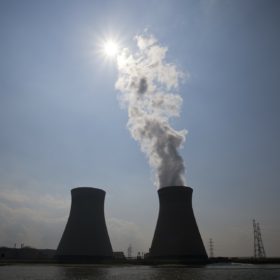
The latest edition of the World Nuclear Industry Status Report gives the energy source little hope in the race against fast, widespread, job-friendly, popular renewables. The report reiterates clean power is taking the lead in the world’s energy system and nuclear is not only too costly a remedy for carbon emissions but too slow to deploy. Nuclear output grew only 2.4% last year while solar and wind power volumes grew 18% and 29%, respectively.
Nuclear power has continued to decline and is becoming increasingly unable to compete on cost and deployment volume with clean energy sources such as solar and wind.
Those are the main conclusions of the 2019 edition of the World Nuclear Industry Status Report (WNISR), published each year by French nuclear consultant Mycle Schneider. In a gloomy outlook for the industry, the report adds the time needed to deploy new nuclear is further handicapping its ability to reduce carbon emissions.
The report’s authors are convinced the age of centralized, inflexible coal and nuclear power generation is coming to an end, hastening the demise of both energy sources.
Today’s study does point out, however, the 417 nuclear reactors in 31 countries still in operation have a record generation capacity of 370 GW, surpassing the 368 GW registered in 2006.
According to the latest survey, 272 reactors – two-thirds of the global fleet – have been operating for more than 30 years and in a decade or less most will have to be replaced by new generation capacity. “In the following decade to 2030, 188 units (165.5 GW) would have to be replaced – 3.2 times the number of start-ups achieved over the past decade, including 80 (19%) that have reached 41 years or more,” the report stated.
Uncompetitive
In the middle of this year, 28 reactors – 24 of them in Japan – are in long-term outage, indicating they have not generated power in the previous calendar year and first half of the current year. At least 27 of the 46 units under construction are behind schedule, mostly by several years, and only nine of the 17 units scheduled for start-up last year were connected to the grid.
Many reactors are uncompetitive against renewables in day-to-day electricity markets, in particular in the United States, and will shut down a decade or more before their licenses expire unless bailed out by new subsidies. The report explains that of “the prohibitive capital cost of [latest type] Gen-III+ reactors – on the order of $5,000-8,000-plus per kilowatt – 78-87% is for non-nuclear costs”. The authors add: “Thus, if the other 13-22% – the ‘nuclear island’ (nuclear steam supply system) – were free, the rest of the plant would still be grossly uncompetitive with renewables or efficiency. That is, even free steam from any kind of fuel, fission or fusion is not good enough because the rest of the plant costs too much.”
The advance of renewables, on the other hand, appears unstoppable, with solar and wind adding 96 GW and 49.2 GW of generation capacity, respectively, last year. Nuclear claimed an 8.8 GW share. Power output from solar and wind grew 13% and 29%, respectively, as nuclear saw meager growth of 2.4%. And while the estimated levelized cost of energy for utility scale solar has fallen by 88% in a decade – and wind 69% – the nuclear power price has surged 23%.
Even if a realistic carbon price were levied across the world, nuclear would trail renewables, according to today’s report.
“Remarkably, over the past two years the largest historic nuclear builder – Westinghouse – and its French counterpart AREVA went bankrupt,” the report states. Reactors that have extended their lifetimes and made safety-upgrade investments, and whose original construction costs were already amortized, still face rising operating costs as their age increases the frequency and expense of repairs. “Their operating-cost data are often commercial secrets, but aggregated data reveal fundamental uncompetitiveness against most electric-efficiency investments and many modern renewables,” adds the study.
Too slow to fight climate change
One of the biggest hurdles facing new nuclear is the time it takes to deploy the technology, according to the report. New plants take 5-17 years, much longer than the timescale for deploying utility scale solar or onshore wind. That means fossil-fuel plants continue to emit far more CO2 while awaiting nuclear replacements.
“Nuclear new-build thus costs many times more per kilowatt-hour so it buys many times less climate solution per dollar, than these major low-carbon competitors,” states this year’s WNISR. Renewables have a lower carbon cost per dollar and per year, the report concludes.
Fighting climate change and global warming requires scalable, mass produced and quickly deployed solutions such as solar and wind to be installed by diverse actors with little institutional preparation. Nuclear power, according to the study, is unable to meet any technical or operational need its low-carbon competitors cannot meet better, cheaper and faster.
“Whatever the rationales for continuing and expanding nuclear power, for climate protection it has become counterproductive and the new subsidies and decision rules its owners demand would dramatically slow this decade’s encouraging progress toward cheaper, faster options – more climate-effective solutions,” the report states.
Schneider and his team also stressed vested interests in the nuclear industry remain a major hurdle to renewables deployment and seek to strangle competing, cheaper energy sources in order to attract demand and capital. The study asks: “Why should a particular low-carbon solution, unable to compete after half a century, be awarded walled-garden markets and new subsidies unavailable to other low-carbon solutions?”
Lắp đặt điện mặt trời Khải Minh Tech
https://ift.tt/2X7bF6x
0906633505
info.khaiminhtech@gmail.com
80/39 Trần Quang Diệu, Phường 14, Quận 3
Lắp đặt điện mặt trời Khải Minh Tech
https://ift.tt/2ZH4TRU
Không có nhận xét nào:
Đăng nhận xét